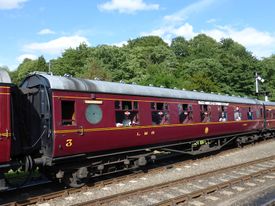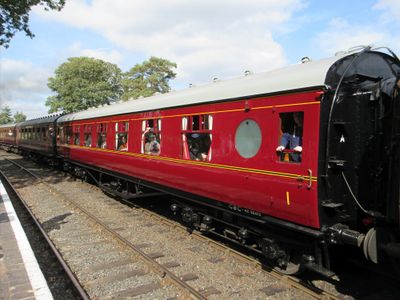LMS 24617 Corridor Composite
| LMS 24617 Corridor Composite | |
|---|---|
 LMS 24617 Corridor Composite (2015) | |
| Built By | BR Derby |
| Status | In service |
| Number | 24617 |
| Other numbers | M24617, SC24617M, W24617M |
| History | |
| Built | 1949 |
| Designed By | Stanier |
| Diagram | 2159 |
| Lot | 1500 |
| Type | CBC, CK |
| Length | 60ft 0¾in |
| Weight | 30T |
| Seats | 24 first, 18 third |
| 1968 | Arrived on SVR |
The LMS had begun to build the first batches of all-steel, welded construction coaches by 1938, although the Second World War and post-war rationing of steel interrupted this programme. Sir William Stanier was succeeded as CME of the LMS by C E Fairburn in 1944 and H G Ivatt in 1945. Although neither produced any new carriage designs, they did implement some of Stanier's style changes. Among those was the port-hole stock, echoing that used by the 1938 streamliners.
In 1947 the LMS began construction of a new all-steel composite carriage, No 24500, to Diagram 2159. The steel framing and all-welded construction gave a slightly more rounded profile than the earlier timber-framed stock.[2] It has four First class and three Third class compartments each seating six passengers, with a lavatory at each end. By the time this was completed in early 1948 the LMS had become part of British Railways. BR went on to build a total of 240 of the type over the next two years, the first 75 in LMS colours but without the LMS branding and the remainder including No 24617 delivered in the new crimson and cream colours[3].
Contents
Contents
Service
24617 was built by BR at Derby in June 1950, as part of Lot number 1500 to Diagram 2159. On entry to service in that year it would briefly have carried the number M24617, the 'M' denoting its LMS origin. BR changed its numbering system in 1951 to account for the introduction of the new Mark 1 stock, resulting in it becoming SC24617M, the prefix indicating it was one of a batch allocated to BR's newly-formed Scottish region.[4]
24617 was later transferred to BR's Western Region, becoming W24617M. It served in the Western Region until 1968, when it was declared surplus to requirements by BR at Didcot only weeks after a full works overhaul and repaint in BR maroon livery[2].
Preservation
24617 was acquired for preservation by the L.M.S. & B.R. Coach Fund. It was one of seven vehicles to arrive on the SVR from Didcot on 28 August 1968, the other two GWR and four LMS carriages having been acquired in a 'package deal' by various groups and individuals. From the time of their arrival it was always intended that the LMS vehicles would eventually be restored to LMS livery,[5] although with 24617 being in virtually ex-works condition it was unlikely that would take place in the immediate future.
A visit by the Stanier 8F Society to the Derby Litchurch Lane Carriage Works Open Day in August 1972 resulted in an invitation for 8233 and three LMS coaches to be exhibited at the following year's Open Day on 11 August 1973. Repairs to Corridor Third 12992 took longer than anticipated and in July a late decision was made to send 24617 instead, being both Derby built and in the best condition of the 1968 batch.[6][5] Time constraints allowed only for a quick repaint and lettering of 24617 in the same BR Maroon livery, which was carried out at Hampton Loade.[6]
24617 was the carriage that Richard Hannay (Robert Powell) boarded at the start of the railway scenes in the 1978 film The Thirty Nine Steps. 24617 and the other carriages from the LMS set used in filming were given 'Midland Railway' decals as the film was set in 1914, although the BR era number W24617M was left unaltered.
During 1979 the first class seating was re-upholstered and the windows re-bedded.[7] The following summer a number of panels were replaced, particularly on the corners, followed by a quick rub down and coat of paint, partially lined and lettered in LMS 1947 style, ahead of a planned withdrawal from service at the end of the season for a full repaint and reupholstering of the third class.[8]
No work had been necessary on the running gear apart from routine maintenance until 1984. 24617's bogies were different from the other spare LMS ones in that the access for the dynamo pulley belt is on the opposite side, so when a bogie overhaul became due, instead of a simple bogie swap, 24617 had to stand on a spare set of bogies (ex 27218) while its own were dismantled, descaled, repaired and painted. In summer 1985 the external doors were re-skinned and an exterior repaint in 1946 LMS livery was carried out.[9]
In winter 1986-7 it received nearly new (1985) battery sets and the third class compartment ceilings were repainted. The following winter the third class corridor walls and doors were cleaned down and re-varnished and attention was also given to the first class fold-up armrests, the latter after a passenger tried to claim a refund due to the arm-rests having had the stitches picked out by other first class passengers![10]
By the end of 1988, 24617 had not missed a season in service in its first twenty years. The annual winter inspection, as it had become, included first class seat repairs, both toilets being redecorated, and one gangway given adaptor equipment for use with BR Mark 1 stock.[11]
As a result of its all-steel construction, repair issues on 24617 are more akin to BR Mark 1 stock than the earlier wooden-framed vehicles. In late 1991 repairs were undertaken at Bewdley during which a quantity of life-expired panelling was cut out, especially on the corners and roof edges, with new panelling being welded in. The vehicle was then repainted and returned to traffic, although later that year it spent another short period out of service while a broken spring and loose horn guides were attended to at Kidderminster.[12]
At the end of 2001, 24617 had still not missed a season in service, although it had not had a full works visit since the work at Bewdley ten years earlier. On this occasion the repair and renewal work at Kidderminster took some 759 man-hours over a period of six weeks, followed by a further 450 man-hours in the paint shop for priming, filling, flatting, surfacer, undercoat, gloss, lettering, lining and varnishing. 24617 was completed at the end of March 2002.[13]
In 2007 the former owning group, the LMS & BR Coach Fund, donated all its vehicles including 24617 to the SVR Rolling Stock Trust (now known as the SVR Charitable Trust).
By December 2008 24617 had completed an unbroken record of 40 seasons in service. It returned to Kidderminster paint shop as part of a refresh of the LMS set which had been in progress for several years, interrupted by the 2007 Storm Damage. The windows received new skates and springs throughout, while a new gangway canvas was fitted at the third class end. The vestibule floor at the same end had become rotten and was renewed. The entire interior was rubbed down and re-varnished, after which all the ceilings were cleaned and repainted. Externally the paintwork was refreshed although without a full repaint on this occasion. The seats were also re-covered with fabric paid for by the Rolling Stock Trust.[14]
At the end of 2022 24617 entered Kidderminster paint shop for "the biggest overhaul of its 72-year life." Investigation of leaks in both toilet roof areas were found to be due to a combination of corroded roof skin and porous water tanks. Unusually each toilet had two water tanks, possibly intended for long-distance work. These were replaced by one new stainless steel tank per lavatory, fabricated by a local Bridgnorth firm.[15].
Most of the LMS carriages have gunmetal frames which do not suffer from corrosion, but 24617 has the SVR's oldest set of aluminium windows. All 14 windows were removed and refurbished, including replacing whole lengths with new aluminium bar. New toughened glass was also fitted.[15]
The interior received a major revamp, with the old varnish being stripped from the veneered panels. During this work, repairers found pencilled scribblings on the exposed walls from those who built the coach. Some form of spelling test was in one compartment, piecework rates were calculated elsewhere, and a roll call of the assembly team appears on another wall. The team documented all the original graffiti in the coach which remains untouched hidden behind veneer panels, added to with a 2022 team roll call of volunteers and paid staff.[16] The coach was also rewired to replace the original rubber-coated wiring. By the 2023 Open House Weekend the first class compartments were sufficiently complete to be displayed together with working compartment lights and wall lights.[17]
Other work carried out included replacement of the linoleum flooring, gangway bellows, upholstery, and restored tables. The coach was repainted, not in the normal LMS pre-war Period 3 livery but in 1948/9 British Transport Commission livery, numbered M24617. It re-entered service in time to appear in the 2023 Autumn Steam Gala, maintaining its record of running at least one day in service in every season since its arrival in 1968[1].
24617 normally forms part of the LMS Maroon set (Set L), notwithstanding that it was not built until after nationalisation.
See also
References
- ↑ 1.0 1.1 Branch Lines, September 2023
- ↑ 2.0 2.1 Charitable Trust 24617 page
- ↑ Jenkinson & Essery (1977) p. 110.
- ↑ Longworth (2018) p.208.
- ↑ 5.0 5.1 SVR Stock Book Second Edition
- ↑ 6.0 6.1 SVR News 29
- ↑ SVR News 51, 54
- ↑ SVR News 56
- ↑ SVR News 72, 77
- ↑ SVR News 84, 87
- ↑ SVR News 90, 92
- ↑ SVR News 102, 104
- ↑ SVR News 139, 141
- ↑ SVR News 164, 167
- ↑ 15.0 15.1 SVR News 221
- ↑ Branch Lines, December 2022
- ↑ SVR News 222
Links
| ||||||||||||||||||||||||||||||
